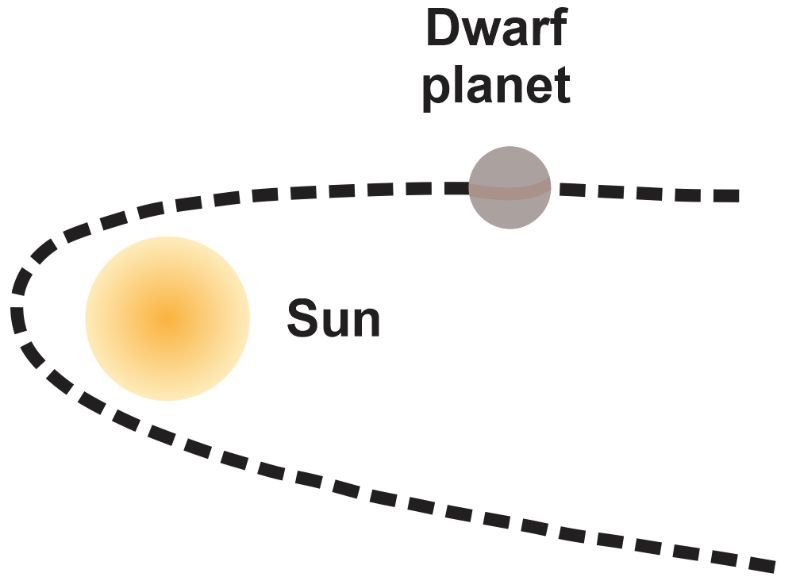- Download the worksheet to save time writing
- Start solving the practice problems
- If you're stuck, watch the video solutions
- See your summary to get more insights

Scientists have spotted a large space debris orbiting the Earth at an altitude of 13,000 nautical miles above the surface. Given that 1 nautical mile = 1.852 km, the mass of the Earth is 5.97 × 1024 kg, the radius of the Earth is 6370 km, and the gravitational constant G = 6.67 × 10-11 Nm2/kg2, find the speed of the space debris.
Imagine a planetary system located roughly 35,000 light years from the core of the Andromeda galaxy. A light year represents the distance light covers in a year traveling at 3.0 × 108 m/s. This system orbits the galaxy's center at a velocity of around 250 km/s. What would be the estimated mass of the galaxy's center, if most of the mass is concentrated near the core and the mass within the orbit is spherically distributed, similar to a giant star?
A planet is located at a distance of 30000 light-years from the center of the Milky Way galaxy. Research has confirmed that the planet has a velocity of 190 km/s when moving about the center of the Milky Way. Determine the number of orbits completed by the planet if it came into existence 6 billion years ago. One light year equals the distance light covers in one year at a speed of 3.0 × 108 m/s.
NASA's TESS found in 2020 an unusual gas giant exoplanet, TOI-2109 b, that orbit an F-type star. TOI-2109 b needs 16 hours, the shortest ever measured for a gas giant exoplanet, to complete one orbit around its parent star. TOI-2109 b mean distance from its star is 2.67 × 106 km. How fast, in Km/s, is this planet moving?
The most eccentric planet, HD 20782 b, has been identified in the constellation of Fornax, orbiting its parent star. HD 20782 b has an orbital eccentricity of 0.96, with a semi-major axis of 2.03 × 108 km. Calculate (i) the distance of HD 20782 b from its parent star at the farthest point (dmax) ii) the distance between HD 20782 b and its parent star at its closest approach (dmin).
An artificial satellite with a mass 'm' is in orbit around a distant planet Rubix of mass 4.5 x 1025 kg. The asteroid's orbital period around planet Rubix is 2 days. Determine the radius of its orbit.
A new dwarf planet has been discovered orbiting beyond Pluto. Observations suggest it completes one orbit around the Sun every 280 years. Use Kepler's Third Law to estimate the farthest distance (aphelion) of the dwarf planet from the Sun. Is the dwarf planet still within the Kuiper Belt, which extends to about 50 AU from the Sun?
It is known that, the minimum velocity required by a spaceship to leave planet X is four times that needed to leave planet Y. Given that both planets X and Y have the same mass, calculate the ratio of the radius of planet X to that of planet Y (rx / ry).
A spacecraft is located at a distance from the sun equal to that of Jupiter's orbit and it needs to escape the solar system. Determine the minimum speed for the spacecraft to escape the gravitational pull of the sun.
An artificial satellite having a mass of 100 kg orbits around a planet following a circular path having a diameter of 700 km. Due to some technical glitch, its velocity reduces suddenly by 30% leading it into an elliptical trajectory. What will be the maximum and minimum distance from the center of the planet on this new trajectory? .[Mass of the planet = 3.5 × 1020 kg.]
Determine the gravitational potential energy of a rod-cylinder system where a thin, uniform rod of length L and mass M is aligned along an axis and a small uniform cylinder with mass m located a distance y from one end of the rod along the same axis. Assume y is significantly greater than L. Take the potential energy to be zero when the rod and cylinder are infinitely separated.
A spacecraft with a mass of 4500 kg is in a circular orbit 200 km above Jupiter's surface. The spacecraft must use its thrusters to transition to a higher circular orbit, 600 km above the surface. Given that Jupiter has a radius of 69,911 km and a mass of 1.89 × 1027 kg, calculate the amount of work required for the thrusters to move the spacecraft from its initial orbit to the higher orbit.
